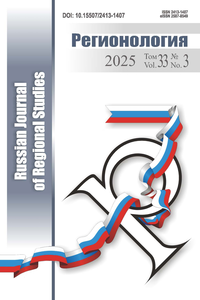Maria A. Zyryanova (Shishkina). Determinants of Birth Rate in the Northern Regions of Russia: Results of the All-Russian Population Censuses
UDC 314.3(470.1/.2)
DOI: 10.15507/2413-1407.103.026.201802.358-383
Maria A. Zyryanova (Shishkina), Junior Researcher of Institute of SocioEconomic and Energy Problems of the North, Komi Science Center, Ural Branch, Russian Academy of Sciences (26 Kommunisticheskaya St., GSP-2, Syktyvkar 167982, Russia), ORCID: https://orcid.org/0000-0002-3567-3470, Researcher ID: C-6046-2018, maria-shishkina18@mail.ru
Introduction. The study is of relevance as the birth rate remains low in most Northern regions, which makes it necessary to find its determinants in order to devise strategies of demographic development. This article aims at identification of the most important factors in the birth rate of the population in the Northern regions of Russia according to the results of the All-Russian Population Censuses and at justification of the topical directions of the demographic policy on the basis of the obtained results. Materials and Methods. The results of the 2002 and 2010 All-Russian Population Censuses and the data provided by the Federal State Statistics Service were used as materials for the study. The role of the factors of the marital and age structure, reproductive behavior was estimated using the V. A. Borisov technique. Correlation analysis was performed to find the relationship between the birth rate and a statistical indicator reflecting the state of a certain factor. Results. An increase in the degree of implementation of the hypothetical minimum of the natural birth rate in 2010 compared with 2002 has been detected, which indicates the impact of changes in the reproductive behavior of the population on the birth rate trends. It has been proved that the peculiarities of reproductive behavior of indigenous ethnic groups remain one of the main determinants of a higher birth rate in a number of the Northern regions. It has been proved that becoming more and more widespread, completed higher education ceases to play an important role as a birth rate factor, and the state of being married has an increasing impact on the average number of children born. Correlation analysis has shown that in regions with higher levels of female economic activity, the average number of children born is lower. Discussion and Conclusions. The results of the study may be used by the authorities when developing programs for family demographic policies; they may also be of interest to scientists studying the issues of reproduction of the population. In the future, it is planned to find a connection between the birth rate and socio-economic indicators in the Northern regions of Russia using correlation and regression analysis.
Keywords: birth rate, birth rate factors, demographic structure, reproductive behavior, ethnic origin, marital status, education, employment, Northern regions of Russia
Acknowledgments. The article was prepared within the framework of the research "Demographic and labor factors of sustainable development in the Northern regions of Russia" (No. GR АААА-А16-116021210329-2, 2016-2018).
REFERENCES
1. Kalachikova O.N., Shabunova A.A. Opportunities for and potential of the birth rate increase in Russia. Problemy razvitiya territorii = Problems of Territory's Development. 2013; 6(68):66-72. Available at: http://pdt.vscc.ac.ru/article/1112 (accessed 25.02.2018). (In Russ.)
2. Popova L.A. Demographic policy in Northern Russia: Reculiarities and priorities. Region: ehkonomika i sociologiya = Region: Economics and Sociology. 2010; 3:136-153. Available at: http://recis.ru/region/magazine/39/1755 (accessed 25.02.2018). (In Russ.)
3. Gurko T.A. [Institution of family in postindustrial societies]. Cennosti i smysly = Values and Meanings. 2011; 4:26-44. Available at: http://tsennosti.instet.ru/directions-2.html (accessed 25.02.2018). (In Russ.)
4. Kachalkin V.M. [The Subject and the Object of Demographic Policy in the Conditions of Democratic State]. Srednerusskij Vestnik obshchestvennyh nauk = Central Russian Bulletin of Social Science. 2014; 4:49-55. Available at: https://cyberleninka.ru/article/n/subekt-i-obekt-demograficheskoy-politiki-v-usloviyah-demokraticheskogo-gosudarstva (accessed 25.02.2018).
5. Pyanov A.I. Changes in the substantial potential of a modern Russian family's functioning. Izvestiya Rossijskogo gosudarstvennogo pedagogicheskogo universiteta im. A.I. Gercena = Izvestia: Herzen University Journal of Humanities & Science. 2009; 89:64-73. Available at: https://lib.herzen.spb.ru/m/rgpu-periodic/1/99 (accessed 25.02.2018). (In Russ.)
6. Bagirova A.P., Shubat O.M. [Forecasting second births among Russian women: sociological and statistical approach]. Problemy prognozirovaniya = Issues of Forecasting. 2014; 3(144):131-140. Available at: https://ecfor.ru/publication/prognozirovanie-vtoryh-rozhdenij-u-rossijskih-zhenshhin (accessed25.02.2018). (In Russ.)
7. Begall K. How do educational and occupational recourses relate to the timing of the family formation? A couple analysis of the Netherlands. Demographic Research. 2013; 29:907-936. Available at: http://www.demographic-research.org/Volumes/Vol29/9 (accessed 25.02.2018).
8. Caldzell J.C. Mass education as a determinant of the timing of fertility decline. Population and Development Review. 1980; 6:225-255. DOI: https://doi.org/10.2307/1972729
9. Comolli Ch.L. The fertility response to the Great Recession in Europe and the United States: structural economic conditions and perceived economic uncertainty. Demographic Research. 2017; 36:1549-1600. DOI: https://doi.org/10.4054/DemRes.2017.36.51
10. Bagirova A.P., Shutova N.V. Parenting in the socio-structural space of the Russian society. Teoriya i praktika obshchestvennogo razvitiya = Theory and Practice of Social Development. 2016; 12:16-20. Available at: http://http://teoria-practica.ru/vipusk-12-2016 (accessed 25.02.2018). (In Russ.)
11. Ilyshev A.M., Bagirova A.P. [Assessment of the status of the sphere of reproductive labor in the period of a crisis and prospects of its change]. Ehko-nomicheskiy analiz: teoriya i praktika = Economic analysis: theory and practice. 2009; 16(145):2-11. Available at: http://www.fin-izdat.ru/journal/analiz/detail.php?ID=15334 (accessed 25.02.2018). (In Russ.)
12. Mosakova E.A. [Employment of women and birth rate in modern Russia]. Vestnik Moskovskogo universiteta = Moscow University Economics Bulletin. Series 6: Economy. 2008; 5:75-85. (In Russ.)
13. Meron M., Widmer I. Unemployment leads women to postpone the birth of their first child. Population. English Edition. 2002; 57:301-330. Available at: https://www.persee.fr/doc/pop_1634-2941_2002_num_57_2_18394 (accessed 25.02.2018).
14. Schleutker E. Women's career strategy choices and fertility in Finland. Finnish Yearbook of Population Research. 2014; 48:103-126. DOI: https://doi.org/10.11588/heidok.00016767
15. Kuzmin A.I., Primak T.V., Kuzmina A.A. [Population reproduction in Russia's regions]. Ekonomika regiona = Economy of Region. 2011; 1:32-41. Available at: http://www.uiec.ru/arhiv_nomerov/2020/1_2012/ (accessed 25.02.2018). (In Russ.)
Submitted 06.03.2018; accepted for publication 10.04.2018; published online 29.06.2018.
For citation: Zyryanova (Shishkina) M.A. Determinants of Birth Rate in the Northern Regions of Russia: Results of the All-Russian Population Censuses. Regionologiya = Regionology. 2018; 27(2):358-383. DOI: 10.15507/2413-1407.103.026.201802.358-383
The author has read and approved the final version of the manuscript.

All the materials of the "REGIONOLOGY" journal are available under Creative Commons «Attribution» 4.0
















